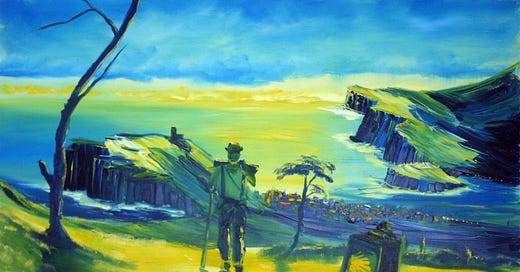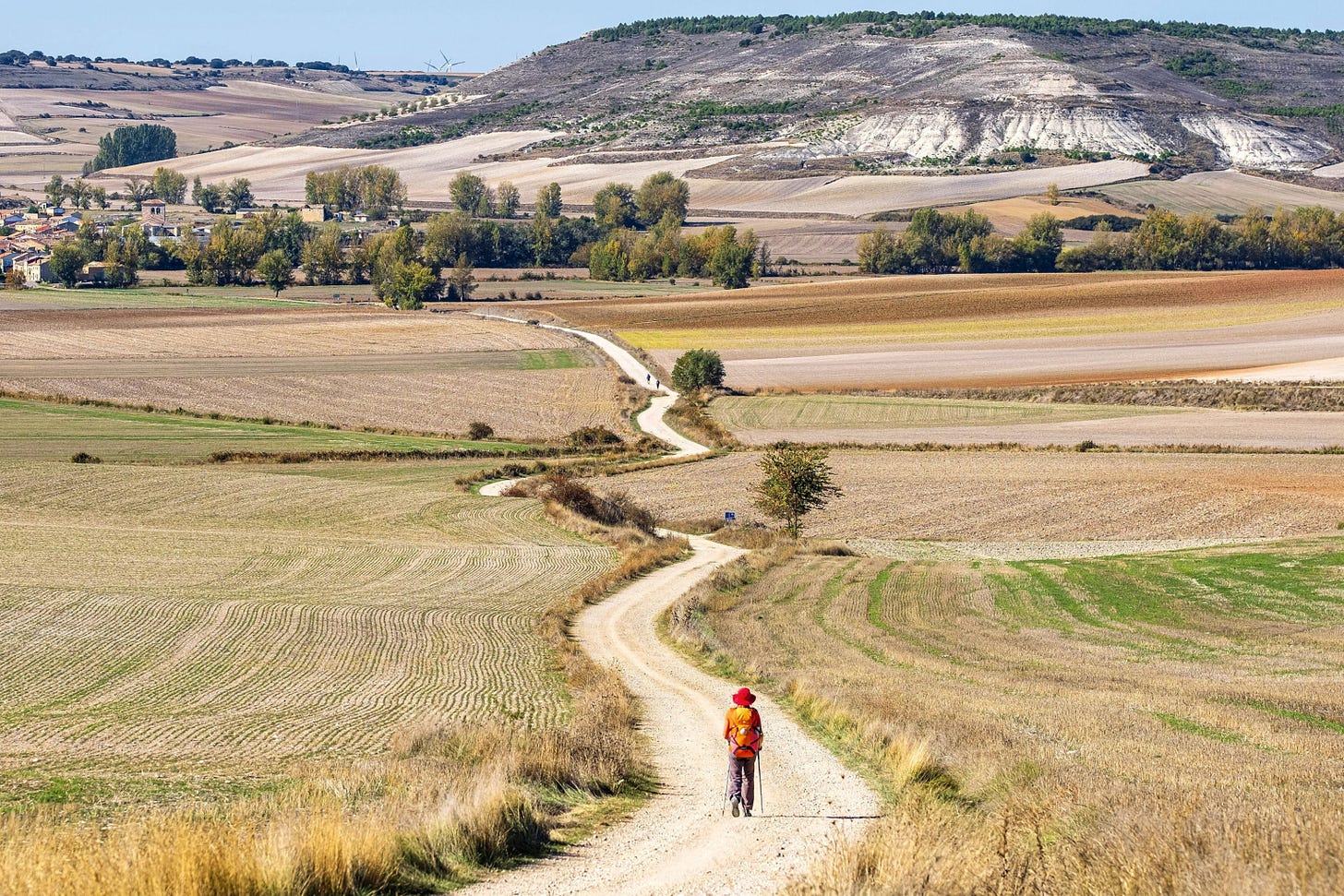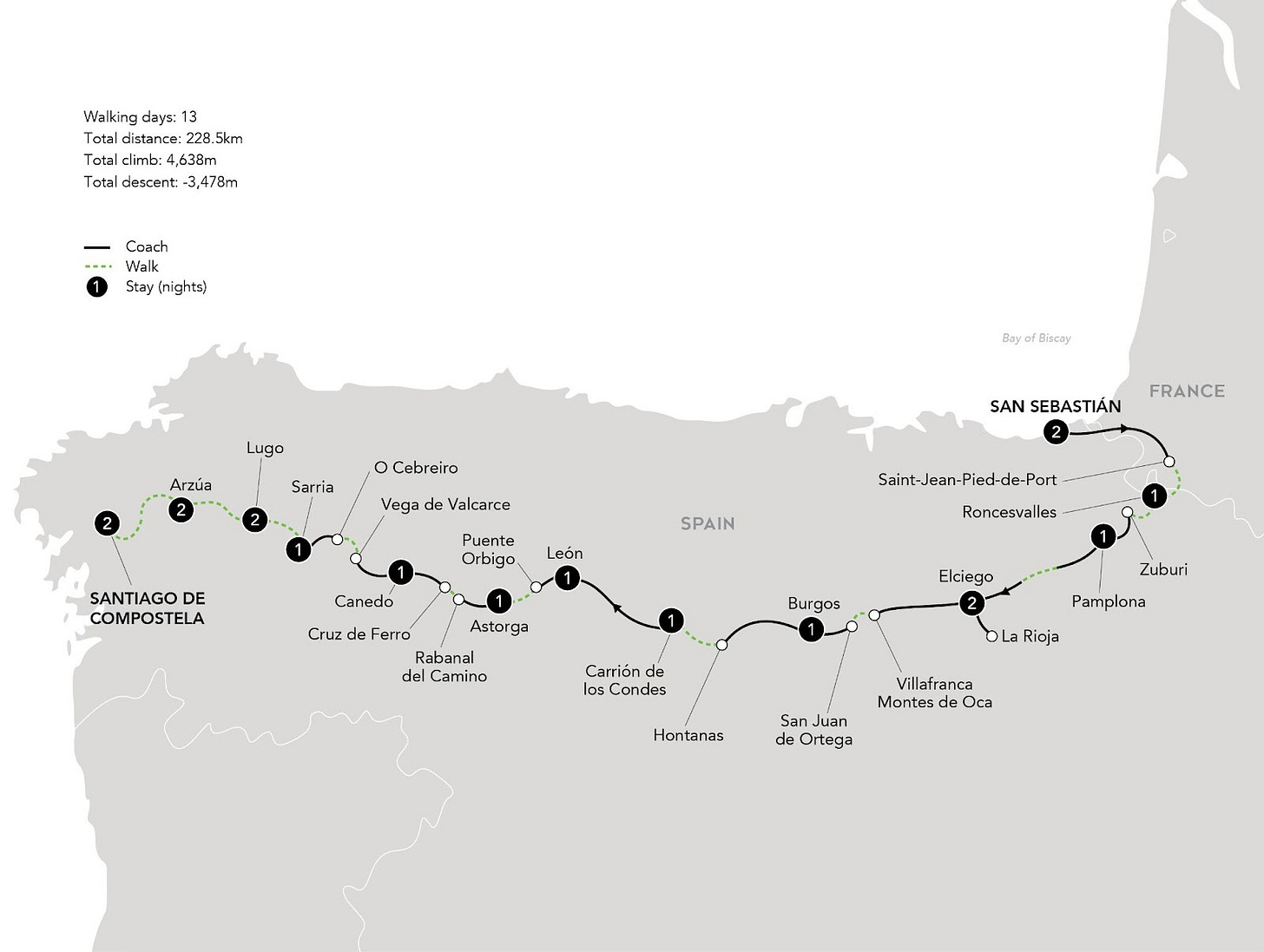“There is ofcourse a deep spiritual need which the pilgrimage seems to satisfy, particularly for those hardy enough to tackle the journey on foot.” (Mullins, 2001)
Painting by Christian Seebauer
Last month we asked this question.. many religions around the world hold walking as the highest order of pilgrimage, which leads one straight to oneself and to one's soul. Then why are we not practicing more of it? And what’s the difference between walking on a treadmill and walking in the nature? or are both the same thing? and we said that we’ll discuss it further each month. So, let’s start with the most obvious pilgrimage; Camino de Santiago. Here’s a brief description of Camino for the Gen Z. If you are older than Gen Z, you can amuse yourself with the evolved English language.
Right, so the Camino de Santiago isn't your typical road trip or highway vibe—it's legit a path that people from all sorts of backgrounds have been strolling for over 2,000 years. Christians, like way back, have been on this journey for nearly 1,300 years. Imagine using a guidebook from 900 years ago to navigate your way through, cruising over Roman pavement that's been holding it down for two millennia. Even James Michener, this OG world traveler, called it "the finest journey in Spain, and one of two or three in the world," and he did it three times!
So, this ancient route got the European Union nod and is now officially a European Heritage Route. Christians are all about it 'cause of this legend that Santiago de Compostela is where James the Greater got laid to rest, putting it up there with Rome and Jerusalem for pilgrim hype.
The Camino de Santiago's roots go back to pre-Christian times when Celtic/Iberian tribes were making their way to the Atlantic coast, feeling the spiritual vibes watching the sun set over the endless waters. Fast forward to the Romans, they took over, laid down some serious roads, and part of that OG road is still part of today's Camino.
Legend has it James the Greater, one of the apostles, rolled into Galicia, did his thing, and then got beheaded back in Palestine. A 2,000-year-old story says his crew brought him back to Galicia for a burial.
Now, back in the 12th and 13th centuries, the Camino de Santiago was like the Coachella for pilgrims—half a million making their way across northern Spain and back each year. Local bigwigs and the church hooked it up with hospitals, hostels, roads, and bridges to keep the party going. The Knights Templar were even on patrol, offering protection, hospitality, healing, and a banking system that made them mad rich.
But here's the real deal on why you should hit the Camino: it's not just a trip, it's a vibe. The views are next level, described as "exquisite," and the whole experience connects you with history, spirituality, and nature. In a world where everything's go, go, go, and screens are life, the Camino slows it down. It's a chance to get back to basics, soak in nature, and find your chill by putting one foot in front of the other. The Camino de Santiago isn't just a path; it's a journey to history, vibes, and discovering your true self. Time to lace up those kicks and get on the wave!
Now, if you have sticked with me so far, thankyou. I don’t speak like a Gen Z and nor do I write like one. This is just an attempt to lure you in if you are Gen Z. Anyway, now back to Old English.
‘Ultreya’, a word that has been synonymous with the Camino; literally means ‘keep going’. Camino is said to be a journey of the feet, the mind and that of one's heart. It is a walk that has no fixed starting point, but it starts by getting oneself on ‘the way’. A deep sense of isolation from the surrounding, the civilisation, marks the path to Santiago. Turner (1974) discusses the idea of liminality - “non-place”. This “non-place”, exists when one exits the said society that they comprise of. When I walked through my own Camino in India, I experienced a similar dissolution of society, space and time.
Walking without a purpose
Before starting to walk, pilgrims arrive at the consideration of all the other facets of the pilgrimage; the obvious religious aspect, the framework of the walk. Soon though, pilgrims’ come to a mental place where they think critically and later instinctively. Then, after a few days on the walk, instinct turns into a natural process, where thinking subsides and frequent gaps of no-mind occur in the experience of the pilgrim. It was this transformation of thought to no-thought was what interested me.
Santiago de Compostela is not a fun experience, to say the least. Some people experience an outpour of emotions. It is a physical as well as mental fatigue to start with. It puts ‘self-doubt’ at the core of each pilgrims’ experience. Insofar as the pilgrimage gives answers, it raises many more questions. Agreeing with this doubt as an empirical fact creates a coherent association between truth and the one physically doing the act of walking.
Fig 1. Louis Carlos Ferraz, The Fields on the way to Santiago.
To understand and examine the walk - Camino to Santiago de Compostela, I spoke with Nehuen (age 34) who has been twice on the Camino.
He says his journey began with not ‘realising’ how important it is to listen to his body. Realisation here implies that the knowledge gained possibly pre-existed Nehuen’s awareness. Starting the Camino is what unfolded those ideas. He emphasises this with the use of the metaphor ‘you look inside yourself’. In this moment of self-reflection he describes himself as the cause and the effect. ‘Camino is teaching you things’- they arrive from the walk.
Fig 2. Map of Camino de Santiago.
Dissolving of Time
He says, ‘In the way you will find many lonely gaps’, here Nehuen is reflecting upon a shift that took place for him within a couple of days into the walk. When Nehuen speaks ‘as if time has frozen’, he evokes the idea that Eckhart Tolle (1997) presents in his book, the Power of Now. Tolle presents time as not flowing linearly, but a combination of past, present and the future that is always happening in the presence of the current moment; current for each observer. Past and future are but the projections of the mind, past persists in memory and the future is created in imagination. Yet, for Tolle (1997); ‘we always stay in the present moment.’
Nature precedes both space and time. The presence of the moment which Lao Tzu calls the ‘dao’ which is elemental to the being. Nehuen expresses a set of convictions that are familiar amid walking pilgrims. He points towards the change from the physical, material dimension to a spiritual and ethereal dimension. It is interesting to observe that the realisation that Nehuen has, to which he refers as spirituality or unearthly, is made possible by a process that uses physicality or the material practice of walking.
While Nehuen candidly shared his experiences on the Camino de Santiago, shedding light on his perspective of the journey and perhaps downplaying the significance for those who undertake it for "religious reasons," it's interesting to juxtapose this against another cultural pilgrimage taking place in a vastly different context – the Waari in India.
India, deeply intertwined with its rich tapestry of religions, sees thousands embarking on the Waari, a pilgrimage that many scholars indeed classify as a religious practice. Nehuen, perhaps unknowingly, brings attention to the diverse motivations people have for undertaking pilgrimages, and in a country like India, religious fervor plays a pivotal role in shaping the collective consciousness.
It's a journey that transcends the physical act of walking; it's a profound cultural and spiritual experience. In India, the convergence of faith, tradition, and devotion manifests in the form of the Waari, a collective pilgrimage to the holy town of Pandharpur.
Two journeys, two continents, and two distinct stories waiting to unfold. Stay tuned as we delve into the spiritual significance of the Waari, where every step echoes centuries of tradition and devotion.
See you next month..










I did the Camino in 2017 and I thought it would be the highlight of my life. It was anything but. However, I didn't have a purpose other than I had the time, money, and was physically fit... so why not? I felt lonely being (just about) the only American and only Christian I met the whole time. I missed being known by my friends and family. Everyone on the Camino was a new friend and you can't make old friends, only new ones, which is how life is I suppose. Many of the pilgrims I met did not like their actual life so for them, the Camino was amazing but for me, I realized I like my actual life and I spent most of the journey just missing home and the feeling of being well known. That was a very beautiful realization to have. When I ended the walk, I thought: "Good riddance!"